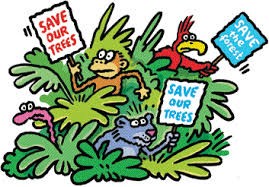Let’s conserve our nature reserve
 Are you aware that about one and a half acres are lost every second of every day? This is due to our greed for more. We are using the trees and natural resources for industrial purposes, for building homes, for consumption of wood and many more reasons. Pollution and air impurity has a lot to do with why certain plants which no longer grow properly in the rain forests. Tropical forest trees, like all green plants, take in carbon dioxide and release oxygen during photosynthesis. Plants also carry out the opposite process, known as respiration, in which they emit carbon dioxide usually in smaller amounts than taken in during photosynthesis. The remaining carbon is stored in the plant, allowing it to grow bigger. That stored carbon would be released into the air as carbon dioxide if deforestation or forest degradation occurs and trees are cut down and allowed to rot or are burned.
Are you aware that about one and a half acres are lost every second of every day? This is due to our greed for more. We are using the trees and natural resources for industrial purposes, for building homes, for consumption of wood and many more reasons. Pollution and air impurity has a lot to do with why certain plants which no longer grow properly in the rain forests. Tropical forest trees, like all green plants, take in carbon dioxide and release oxygen during photosynthesis. Plants also carry out the opposite process, known as respiration, in which they emit carbon dioxide usually in smaller amounts than taken in during photosynthesis. The remaining carbon is stored in the plant, allowing it to grow bigger. That stored carbon would be released into the air as carbon dioxide if deforestation or forest degradation occurs and trees are cut down and allowed to rot or are burned.
Since carbon dioxide is the major source of global warming pollution, tropical deforestation has become an important contributor to global warming. Tropical forests must be protected from deforestation and degradation if we want to reduce emissions to the levels needed to protect the planet against the worst and most expensive global warming impact. Though ending deforestation will not solve the global warming by itself. Ofcourse, we need to curtail the carbon emissions from other sources too.
The major causes of biodiversity decline are rampant land use changes, pollution, changes in atmospheric CO2 concentrations, changes in the nitrogen cycle and acid rain, climate alterations, and the introduction of exotic species, all coincident to human population growth. For rainforests, the primary factor is land conversion. Climate will probably change least in tropical regions, and nitrogen problems are not as important because growth in rainforests is usually limited more by low phosphorus levels than by nitrogen insufficiency. The introduction of exotic species is also less of a problem than in temperate areas because there is so much diversity in tropical forests that newcomers have difficulty becoming established.
Reducing deforestation is more than just a method to reduce global warming pollution. Tropical forests are home to many unique species of animals and plants. Animals like the jaguar will risk becoming extinct if we do not act to protect their home in the tropical forests. In addition, tropical forests are crucial sources of food, medicine, and clean drinking water for people in developing countries. Tropical forests help regulate regional rainfall and prevent both floods and droughts. Thus, reducing deforestation is not only a beneficial action against global warming; it also can make important contributions to saving biodiversity and supporting sustainable development.
Gold, copper, diamonds, and other precious metals and gemstones are important resources that are found in rainforests around the world. Extracting these natural resources is frequently a destructive activity that damages the rainforest ecosystem and causes problems for people living nearby and downstream from mining operations.
According to forest conservation experts, we lose 137 plants, insect, and animal species every day because of the damage that we are causing to the rainforest. This means that 50,000 species are permanently lost every year. This not only means that some animals are no longer in existence, but also indicates that possible cures for severe diseases are also lost. Let’s feel sensitized to this issue; it’s not a joke. It has been proven that about twenty five percent of Western medications are derived from plants that grow in the rainforest. However, less than one percent of these plants have actually been tested before the medication is put on the market.
 The world’s first modern nature reserve was established in 1821 by the naturalist. And explorer Charles Waterton around his estate in Walton Hall, West Yorkshire. He spent then £9000 on the construction of a 3 mile long, 9 ft tall wall to enclose his park from poachers. He tried to encourage birdlife by planting trees and hollowing out trunks for owls to nest in. He also invented artificial nest boxes to house starlings, jackdaws and sand martins and unsuccessfully attempted to introduce little owls from Italy. Mr. Waterton allowed local people access to his reserve and was described by David Attenborough as “one of the first people anywhere to recognize not only that the natural world was of great importance but that it needed protection as humanity made more and more demands on it”.
The world’s first modern nature reserve was established in 1821 by the naturalist. And explorer Charles Waterton around his estate in Walton Hall, West Yorkshire. He spent then £9000 on the construction of a 3 mile long, 9 ft tall wall to enclose his park from poachers. He tried to encourage birdlife by planting trees and hollowing out trunks for owls to nest in. He also invented artificial nest boxes to house starlings, jackdaws and sand martins and unsuccessfully attempted to introduce little owls from Italy. Mr. Waterton allowed local people access to his reserve and was described by David Attenborough as “one of the first people anywhere to recognize not only that the natural world was of great importance but that it needed protection as humanity made more and more demands on it”.
 Sri Lanka needs a special mention in natural conservation. Protected forest areas of Sri Lanka are administrated by Department of Forest Conservation and Department of Wildlife Conservation of Sri Lanka. The country has 501 protected areas under National Heritage Wilderness Area Act in 1988. They manage forest reservations for environmental sustainability. World heritage site, Sinharaja Forest Reserve is an example for a National Heritage forest and friends it is worth a visit in lifetime. There are 32 forests categorized as conservation forests including Knuckles Mountain Range. Strict nature reserve, national parks, forest corridors and sanctuaries are recognized under the Flora and Fauna Protection Ordinance managed by Department of Wildlife Conservation. The effort is worth and laudable.
Sri Lanka needs a special mention in natural conservation. Protected forest areas of Sri Lanka are administrated by Department of Forest Conservation and Department of Wildlife Conservation of Sri Lanka. The country has 501 protected areas under National Heritage Wilderness Area Act in 1988. They manage forest reservations for environmental sustainability. World heritage site, Sinharaja Forest Reserve is an example for a National Heritage forest and friends it is worth a visit in lifetime. There are 32 forests categorized as conservation forests including Knuckles Mountain Range. Strict nature reserve, national parks, forest corridors and sanctuaries are recognized under the Flora and Fauna Protection Ordinance managed by Department of Wildlife Conservation. The effort is worth and laudable.
Australia’s National Reserve System comprises Commonwealth, State and territory controlled reserves, indigenous lands and protected areas managed by not-for-profit organizations, and ecosystems protected by farmers on private land. There are more than 9,700 protected areas, covering over 103 million hectares.
In Egypt, there are 29 nature reserves which cover 12% of Egyptian land. Those nature reserves were built according to the laws no. 102/1983 and 4/1994 for protection of the Egyptian nature reserve. Egypt announced a plan from to build 40 nature reserves from 1997 to 2017, to help protect the natural resources and the culture and history of those areas. The largest nature reserve in Egypt is Gebel Elba (35,600 square kilometers (13,700 sq mi)) in the southeast, on the Red Sea coast.
 In Brazil, nature reserves are classified as Biological Reserves by the National System of Conservation Units. Its main objectives are preserving fauna and flora and other natural attributes, excluding direct human interference. The norms laid down by Government cannot be infringed or altered.
In Brazil, nature reserves are classified as Biological Reserves by the National System of Conservation Units. Its main objectives are preserving fauna and flora and other natural attributes, excluding direct human interference. The norms laid down by Government cannot be infringed or altered.
Forestry in India is a significant rural industry and a major environmental resource. India is one of the ten most forest-rich countries of the world along with the Russian Federation, Brazil, Canada, United States of America, China, Democratic Republic of the Congo, Australia, Indonesia and Sudan. Together, India and these countries account for 67 percent of total forest area of the world. India’s forest cover grew at 0.22% annually over 1990-2000, and has grown at the rate of 0.46% per year over 2000-2010, after decades where forest degradation was a matter of serious concern.
As of 2010, the Food and Agriculture Organization of the United States estimates India’s forest cover to be about 68 million hectares, or 24% of the country’s area. The 2013 Forest Survey of India states its forest cover increased to 69.8 million hectares by 2012, per satellite measurements; this represents an increase of 5,871 square kilometers of forest cover in 2 years. However, the gains were primarily in northern, central and southern Indian states, while northeastern states witnessed a net loss in forest cover over 2010 to 2012. The places that are of great concern these days are the tropical forests, and there are several different types. The most popular type, perhaps, is the rain forest, the largest of which still remain in places like Brazil and Malaysia.
What can we do to participate in forest conservation?
 We can do small things like buying recycled paper to write on or for printing. We can start using shopping bags made out of cloth instead of paper bags for our groceries, shopping, buying vegetables and fruits etc. Using recycled paper towels and toilet paper will help with forest conservation as well. We can start using even recyclable building materials. These small steps will help us to preserve parts of the earth that are disappearing day after day.
We can do small things like buying recycled paper to write on or for printing. We can start using shopping bags made out of cloth instead of paper bags for our groceries, shopping, buying vegetables and fruits etc. Using recycled paper towels and toilet paper will help with forest conservation as well. We can start using even recyclable building materials. These small steps will help us to preserve parts of the earth that are disappearing day after day.
Let us protect wildlife in our own way. Amid the goals of wildlife conservation, one goal is to ensure that nature will be around for future generations to enjoy and to recognize the importance of wildlife and wilderness lands to humans. Wildlife conservation has become an increasingly important practice due to the negative effects of human activity on wildlife. The science of extinction is called Dirology. Endangered species is defined as a population of a living being that is at the danger of becoming extinct because of several reasons. The reasons can include that the species has a very low population or is threatened by the varying environmental or prepositional parameters. Let’s nurture the wilderness lands.
The natural wildlife habitat areas are being used for building and constructions, hence they are reducing at faster pace. Moreover, the habitat that remains has often been degraded to bear little resemblance to the wild areas which existed in the past. Habitat loss due to destruction, fragmentation or degradation of habitat is the primary threat to the survival of wildlife. When an ecosystem has been dramatically changed by human activities such as agriculture, oil and gas exploration, commercial development, mining or water diversion, it may no longer be able to provide the food, water, cover, and places to raise young. Every day there are fewer places left that wildlife can call home.
We’re currently experiencing the worst spate of species die-offs since the loss of the dinosaurs 65 million years ago. Although extinction is a natural phenomenon and it occurs at a natural rate of about one to five species per year. Scientists estimate we’re now losing species with literally dozens going extinct every day. It could be a scary future indeed, with as many as 30 to 50 percent of all species possibly heading toward extinction by end of this century. Before it is too late, let’s start conserving our natural possessions.












































